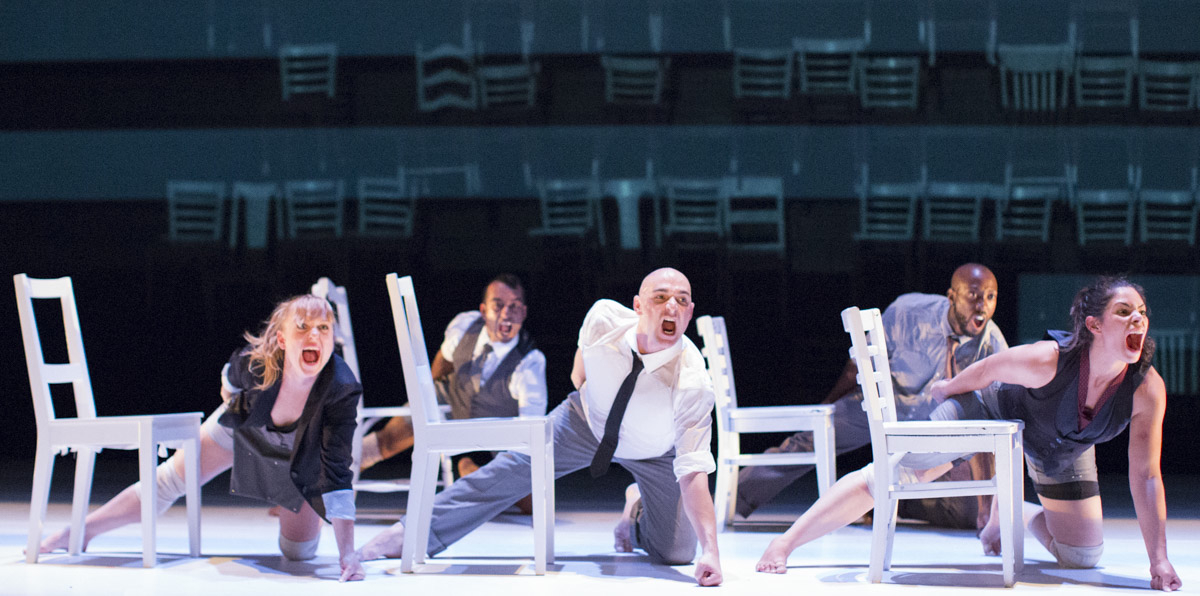Traditional is the last word that comes to mind to describe The Seldoms, whose international and interdisciplinary endeavors as a contemporary dance company defy convention. The Chicago-based ensemble makes “intelligent, visually rich dance theater driven by inquiry” and landed in Brookland last Tuesday as part of Dance Place’s touring artist series. The Seldoms’ itinerary for their week-long residency was extensive, including two professional master classes; auditions and rehearsals with Howard University student dancers to incorporate them into their piece, Power Goes; and two fully produced performances in Dance Place’s Cafritz Foundation Theater this weekend.
Dance Place staff and local dancers sat down with The Seldoms company members this week to exchange personal histories, share tips from the professional field and delve into themes related to the work the ensemble presented. After an open company master class, the hungry dancers helped themselves to lunch donated by locally-owned business &pizza and discussed topics spanning from human anatomy to landfills.
Artistic Director Carrie Hanson founded The Seldoms in 2001 and has since created over 25 new works for the company. Hanson exuded a jovial frankness while describing her evolution as an artist. She graduated from Texas Christian University with a BFA and pursued her Masters at Laban London and now teaches at The Dance Center at Columbia College in Chicago. Several of the The Seldoms company members are graduates of the program. Her multilayered abilities as a dancer, bodywork practitioner, professor and choreographer are evident in her teaching style. While teaching a movement combination, Hanson referred to the specific bones involved in a movement. “I think about directing bones into particular spaces, sagittal, vertical, horizontal,” she says, inadvertently quizzing her dancers on anatomy while demonstrating a phrase. The company’s style is choreographically precise and dynamic; their process is interdisciplinary at its core and visually complex. “When I first started I spent a lot more time in my own body, prioritizing invention. It’s always been really important to me to have a distinctive vocabulary per piece that speaks to a certain topic.” Hanson’s commitment to specificity and discovery have remained constant over the course of The Seldoms’ fifteen years in existence. The company has evolved from presenting more abstract work in traditional settings, to performing site-specific works and generating pieces grounded in real world issues.
Hanson’s affinity for mapping out a seemingly perpetual flow of new projects is a testament to her perseverance and willingness to work in unfamiliar spaces, places, and disciplines. “We put a work in an outdoor pool, in a big 1800 sq-foot garage space, in a cargo shipping container, and worked with an architect. He built out these beautiful minimalist installations; they were pristine and glowing and white inside of this really rough garage. Damon was climbing up a steel girder to a platform. It was raw wasn’t it? We were worried about rust and tetanus.”
Damon Green, a fifth-year company member from Champaign-Urbana, Illinois chuckled through the cringe-worthy memory. “It was a rough space. It was a lot of fun. Two weeks before we went into the space, we went and just cleaned it out.”
Hanson nodded. “We were doing power washing, yeah. Site specific work is great and man, it’s also a beast.”
Hanson’s work has addressed topics such as the 2008 economic crisis and the ongoing climate change debate. When asked if The Seldoms intentionally present “political” work, Hanson responded: “It’s gone there in the last five years. Monument in 2008 kind of turned a corner. The subject matter of the piece is materialism at a broad scope and more specifically trash and landfills. Coincidentally, the guy who owned the trucking garage that we did Convergence ran a large garbage and refuse company. I had this funny relationship with him – he would talk about what makes for a successful landfill. I started reading about that and got interested in it. But it set a new way of working toward more dance theater.”
Hanson deftly channels an intense curiosity about current social issues into her process for generating meaning through movement. Her objective of raising awareness about pressing societal questions rather than advancing an agenda has garnered international attention for The Seldoms and helped Hanson to be named as “Chicagoan of the Year in Dance” in 2015.
Hanson’s foray into choreography that incorporates textual elements is clearly embodied in Power Goes, which The Seldoms performed Saturday and Sunday nights. The piece is a theatrical exploration into how political and social power structures emerge, succeed, and/or fail, utilizing the body as a laboratory. Using the frame of Lyndon B. Johnson’s presidency and quotidian power dynamics of social interactions, the piece reflects on “the performance of power and how power performs.” The historical lens focuses on the United States’ struggles over equality and rights, war and peace, innovation toward the future and yearning for the past, both in the 1960s and present day.
The company continues to investigate how text and dance can work in tandem to be meaningful and engaging. Hanson is wary of relying too heavily on spoken word to deliver content of the piece. “I really hope that we are still delivering information through the body and action between bodies,” she said.
Philip Elson, company member and guest choreographer for The Seldoms, has reflected on the similarities and difference of language and physical movement: “They have a relationship with one another but they’re not the same, even when they happen simultaneously. That’s a really awesome and fun thing to navigate.” In one section of Power Goes, Hanson crafted the danced material to be in tight unison with recorded speech of Presidents Barack Obama and Lyndon Johnson, using dance to amplify the meaning of the text.
“One of the issues there is that if you’re asking people to both listen, for six minutes, and also watch, sometimes those two parts of our brain don’t align. We’re bringing them together,” she said.
The team worked with playwright Stuart Flack to develop a textual framework for the piece that includes live spoken word performance in addition to recorded presidential speeches and video projections of historic images. The evocative sound design by Mikhail Fiksel includes instrumental Americana music by Townes Van Zandt (in honor of LBJ’s Texan roots), Dave Brubeck’s intriguingly playful “Unsquare Dance,” and Jimi Hendrix’s iconic rendition of the Star Spangled Banner.
The Seldoms place the words of Barack Obama alongside those of LBJ, reminding audiences how struggles for power ripple across time. Their geometrically distinctive and undeniably human movement plays with the tension between control and chaos. During this weekend’s performance, twelve additional cast members from Howard University endowed a vignette about nonviolent protest with a profound sense of our collective need for unity and peace, especially when the well-being of society hangs in a precarious balance.
The company members’ versatility as performers is no more evident than in Power Goes, where they serve as vocal as well as physical storytellers. For company member Matthew McMunn, the spoken element of Power Goes is a chance to channel his experience as an actor. “I love working with scripts,” he said. McMunn also graduated from Columbia College in Chicago having majored in Cultural Studies and his eclectic background as both mime actor and stilt-walker, in addition to dancing, is indicative of Hanson’s commitment to collaboration with multifaceted artists.
As with any art form, a choreographer’s stylistic trademarks can become stubborn creative habits that crave disruption. Hanson expressed that she senses patterns emerging in her choreography but has charted a path toward reinvention with help from the International Connections Fund. A branch of the MacArthur Foundation, this grant opportunity aims to create cultural exchanges across diverse artistic disciplines. It is clear she nurtures a healthy curiosity for new perspectives, as evidenced by The Seldoms’ upcoming “Toolbox” project: the ensemble will travel to Glasgow, Scotland this summer to study with a group of visual artists. Hanson calls the trip a “process-oriented event” in which the dancers will translate visual arts tactics into dance-making “tools” rather than generating new work. “Some of those things we anticipate are going to be easy to translate, like the texture or the density or the thickness of paint, or the thickness or quality or texture of movement. What I’m interested in are the tools that are in their toolbox that don’t really align or correspond directly with something that we would be able to do and then what does that force us to make?” The program has in the past also provided a way for The Seldoms to collaborate with dance companies in Siberia and Taiwan. In addition to their extensive geographic travel, The Seldoms delve into new artistic territory by collaborating frequently with artists of various stripes, including visual artists, playwrights, composers, percussionists and fashion designers.
The Seldoms dare to travel back into a tumultuous past of civil upheaval and filter their findings through their bodies. They join a continuous line of dance companies that treats their form as a catalyst for social change, both in the public and private spheres. In a contemporary political moment of deep uncertainty and disorientation, art that initiates deep reflection about how power flows is more essential than ever. Dance Place is fortunate to welcome boundary-shifting companies like The Seldoms into its space; their probing questions will continue to resonate with our audiences long after their footprints are erased from our marley floor.
Article: Rebecca Cohen
Header Photo: William Federking

